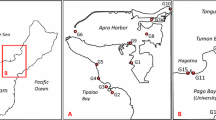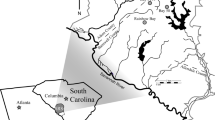Abstract
We report findings from the first laboratory experiments to assess toxicities of metals found in drilling muds to embryos and prezoeae of a brachyuran crab. Embryos of Cancer anthonyi are brooded externally on the abdomen of female crabs; thus, embryos may be continuously exposed to pollutants contained in sediments of contaminated benthic habitats. Lethal concentrations of metals to embryos after 7 d exposures were: iron and barium (sulfate), 1 000 mg l−1; barium (chloride), 100 mg l−1; aluminum and nickel, 10 mg l−1; copper and lead, l mg l−1; cadmium, chromium VI and manganese, ≦0.01 mg l−1; mercury, ≦0.001 mg l−1. All metals effectively retarded embryos from hatching at concentrations equal or lower to those causing mortality, except for cadmium. Particularly impressive was iron, which suppressed hatching at l to 10 mg l−1, concentrations previously found non-deleterious to marine organisms and 100 times more dilute than concentrations causing significant embryo mortality. The effects of metals on embryos increased as a function of exposure duration. Embryo mortality was delayed for at least 120 h at concentrations ≦1.0 mg l−1, with the exception of mercury. Lethal concentrations established at 96 h were meaningless for crab embryos, because acute toxic thresholds were not attained by that time. Larval survivorship to chromium VI, copper, and zinc increased following exposure of embryos to these metals at low concentrations (≦1.0 mg l−1), suggesting induction of biochemical pathways for products which bind or metabolize metals. Identical exposures of embryos to lead failed to enhance subsequent larval survivorship, showing that inductions may be metal-specific. We suggest that exposures of brachyuran embryos at field sites and the success of their subsequent hatching in the laboratory may be a means of assessing environmental contamination otherwise difficult to monitor.
Similar content being viewed by others
Literature cited
Ahsanullah, M., Arnott, G. H. (1978). Acute toxicity of copper, cadmium and zinc to larvae of the crab Paragrapsus quadridentatus (H. Milne Edwards) and implications for water quality criteria. Aust. J. mar. Freshwat. Res. 29: 1–8
Bloom, N. S., Crecelius, E. A. (1984). Determination of silver in sea-water by coprecipitation with cobalt pyrrolidinedithiocarbamate and zeeman graphite-furnace. Analytica chim. Acta 156: 139–145
Boehm, P. D. (1987). Transport and transformation processes regarding hydrocarbon and metal pollutants in offshore sedimentary environments. In: Boesch, D. F., Rabalais, N. N. (eds.) Long-term environmental effects of offshore oil and gas development. Elsevier Applied Science, New York, p. 233–286
Bookhout, C. G., Monroe, R., Forward, R., Costlow, J. D., Jr. (1984). Effects of soluble fractions of drilling fluids on development of crabs, Rhithropanopeus harrissi and Callinectes sapidus. Wat. Air Soil Pollut. 21: 183–187
Calabrese, A., Collier, R. S., Nelson, D. A., MacInnes, J. R. (1973). The toxicity of heavy metals to embryos of the American oyster Crassostrea virginica. Mar. Biol. 18: 162–166
Carls, M. G., Rice, S. D. (1984). Toxic contribution of specific drilling mud components to larval shrimp and crabs. Mar. envirl Res. 12: 45–62
Connor, P. M. (1972). Acute toxicity of heavy metals to some marine larvae. Mar. Pollut. Bull. 3: 190–192
Davis, C. C. (1964). A study of the hatching process in aquatic invertebrates. XIII. Events of eclosion in the American lobster, Homarus americanus Milne-Edwards (Astacura, Homaridae). Am. Midl. Nat. 72: 203–210
Davis, C. C. (1965). A study of the hatching process in aquatic invertebrates. XX. The blue crab Callinectes sapidus Rathbun, XXI. The nemertean, Carcinonemertes carcinophila (Kolliker). Chesapeake Sci 6: 201–208
Glickstein, N. (1978). Acute toxicity of mercury and selenium to Crassostrea gigas embryos and Cancer magister larvae. Mar. Biol. 49: 113–117
Greenwood, J. G., Fielder, D. R. (1983). Acute toxicity of zinc and cadmium to zoeae of three species of portunid crabs (Crustacea: Brachyura). Comp. Biochem. Physiol. 75C: 141–144
Hamilton, S. A. L. (1984). Feeding rates and growth of Carcinonemertes errans. M.S. thesis, California State College, Stanislaus, Turlock
Kuris, A. M. (1971). Population interactions between a shore crab and two symbionts. Ph.D. dissertation, University of California, Berkeley
Laws, E. A. (1981). Aquatic pollution. John Wiley & Sons Inc., New York
Leblanc, G. A. (1982). Laboratory investigation into the development of resistance of Daphnia magna (Straus) to environmental pollutants. Envir. Pollut. 27A: 309–322
Lee, H. H., Xu, C. H. (1984). Effects of metals on sea urchin development: a rapid bioassay. Mar. Pollut. Bull. 15: 18–21
Luoma, S. N. (1983). Bioavailability of trace metals to aquatic organisms—a review. Sci. total Envir. 28: 1–22
Martin, J. L. (1976a). Metabolisme de Fe, Cu, Zn, Mg, Mn, et Co dans les oeufs de Cancer irroratus (Crustace Decapode). C. r. Séanc. Soc. Biol. Filiales 170: 153–156
Martin, J. L. (1976b). Accumulation de Fe, Cu, Zn, Mg, Mn, et Co dans l'ovaire de Carcinus maenus L. au cours de l'ovogenese. C. r. Séanc. Soc. Biol. Filiates 170: 157–162
Martin, M., Osborn, K. E., Billig, P., Glickstein, N. (1981). Toxicities of ten metals to Crassostrea gigas and Mytilus edulis embryos and Cancer magister larvae. Mar. Pollut. Bull. 12: 305–308
Morgan, J. D., Mitchell, D. G., Chapman, P. M. (1986). Industrial and combined toxicity of manganese and molybdenum to mussel, Mytilus edulis larvae. Bull. envir. Contam. Toxic. 37: 303–307
Nacci, D., Jackian, E., Walsh, R. (1986). Comparative evaluation of three rapid toxicity tests: sea urchin early embryo growth test, sea urchin sperm cell toxicity test and microtox. Envir. Toxic. Chem. 5: 521–525
National Research Council (1983). Drilling discharges in the marine environment. National Academy Press, Washington, D.C.
Neff, J. M. (1987). Biological effects of drilling fluids, drill cuttings, and produced waters. In: Boesch, D. F., Rabalais, N. N. (eds.) Long-term environmental effects of offshore oil and gas development. Elsevier Applied Science, New York, p. 469–538
Neff, J. M., Carr, R. S., McCulloch, W. L. (1980). Acute toxicity of a used chrome lignosulphonate drilling mud to several species of marine invertebrates. Mar. envirol Res. 4: 251–266
Neff, J. M., Rabalais, N. N., Boesch, D. F. (1987). Offshore oil and gas development activities potentially causing long-term environmental effects. In: Boesch, D. F., Rabalais, N. N. (eds). Long-term environmental effects of offshore oil and gas development. Elsevier Applied Science, New York, p. 149–174
Okazaki, R. K. (1986). Aspects of feeding behavior of Carcinonemertes errans (Nemertea), an egg predator of the Dungeness crab, Cancer magister. In: Vivares, C. P., Bonami, J. R., Jaspers, E. (eds.) Pathology in marine aquaculture. European Acuaculture Society, Bredene, Belgium, p. 171–181. (Publ. No. 9)
Olafson, R. W., Kearns, A., Sim, R. G. (1979). Heavy metal induction of metallothione synthesis in the hepatopancreas of the crab. Scylla serrata. Comp. Biochem. Physiol. 62B: 417–424
Payne, J. R., Phillips, C. R., Hom, W. (1987). Transport and transformation: water column processes. In: Boesch, D. F., Rabalais, N. N. (eds.) Long-term environmental effects of offshore oil and gas development. Elsevier Applied Science, New York, p. 175–232
Rand, G. M., Petrocelli, S. R. (1985). Fundamentals of aquatic toxicology. Hemisphere Publishing Corp., Washington
Rao, S. R., Saxema, A. B. (1981). Acute toxicity of mercury, zinc, lead, cadmium, manganese to Chironomus species. Int. J. envirl Stud. 16: 225–226
Robertson, D. E., Carpenter, R. (1976). Activation analysis. In: Goldberg, E. D. (ed.) Strategies for marine pollution monitoring. Wiley Interscience, New York, p. 93–160
Roesijadi, G., Drum, A. S., Thomas, J. M., Fellingham, G. W. (1982). Enhanced mercury tolerance in marine mussels and relationship to low molecular weight, mercury-binding proteins. Mar. Pollut. Bull. 13: 250–253
Sanders, B. M., Jenkins, K. D. (1984). Relationships between free cupric ion concentrations in sea water and copper metabolism in crab larvae. Biol. Bull. mar. biol. Lab., Woods Hole 167: 704–712
Shukla, G. S., Singhal, R. L. (1984). The present status of biological effects of toxic metals in the environment: lead, cadmium and manganese. Can. J. Physiol. Pharmac. 62: 1015–1031
Sokal, R. R., Rohlf, F. J. (1981). Biometry. The principles and practice of statistics in biological research. 2nd ed. W. H. Freeman & Co., San Francisco
Tillery, J. B., Thom, R. E. (1981). Metals: studies in sediments and fauna. In: Bedinger, C. A., Jr. (ed.) Ecological investigations of petroleum production platforms in the central Gulf of Mexico, Vol. 1. Pollutant fate and effect study, Part 4. Kesearch Institute, San Antonio, Texas, p. 1–122
Vernberg, W. B., DeCoursey, P. J., Padgett, W. J. (1973). Synergistic effects of environmental variables on larvae of Ucaa pugilator. Mar. Biol. 22: 307–312
Zacks, S. (1981). Parametric statistical inference, basic theory, and modern approaches. Pergamon Press, Oxford
Author information
Authors and Affiliations
Additional information
Communicated by R. S. Carney, Baton Rouge
Rights and permissions
About this article
Cite this article
Macdonald, J.M., Shields, J.D. & Zimmer-Faust, R.K. Acute toxicities of eleven metals to early life-history stages of the yellow crab Cancer anthonyi . Mar. Biol. 98, 201–207 (1988). https://doi.org/10.1007/BF00391195
Accepted:
Issue Date:
DOI: https://doi.org/10.1007/BF00391195




